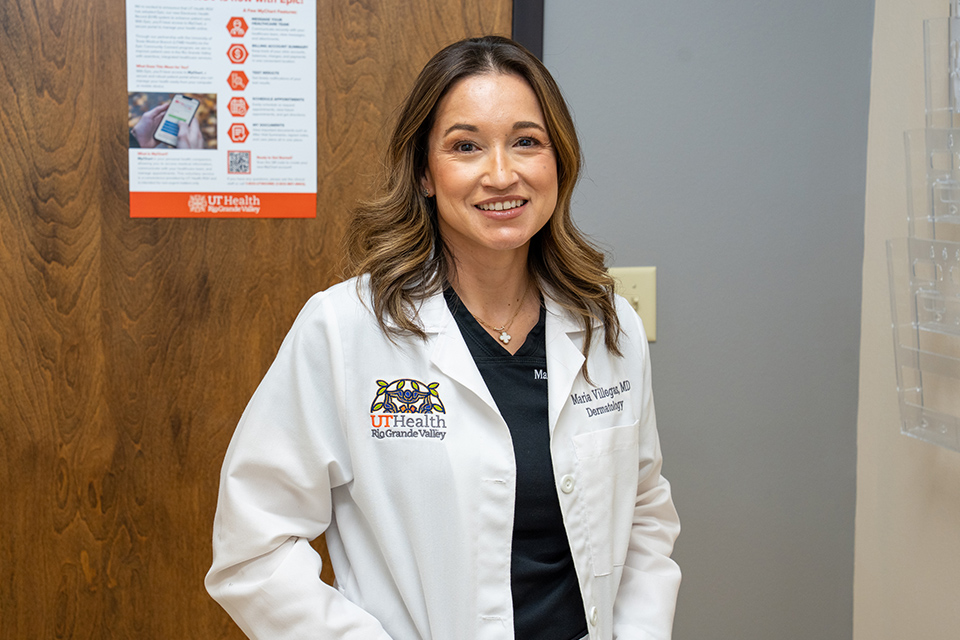By Heriberto Perez–Zuñiga
RIO GRANDE VALLEY, TEXAS – JULY 7, 2025 – While sunshine is part of what makes summer special, it also brings serious heat and strong ultraviolet (UV) rays. With temperatures routinely nearing triple digits, Valley families need to take extra steps to protect their skin from sunburn, infection and long-term damage.
Dr. Maria Villegas, an adult and pediatric dermatologist at UT Health RGV, notes that skin issues such as sunburns, rashes and fungal infections increase with the Valley heat, and it’s essential to stay one step ahead.
“We live in a part of the country where people are exposed to strong sun almost year-round,” Villegas said. “That chronic sun exposure adds up. UV rays damage the skin even when you’re not getting burned. Prevention has to start early.”
SUMMER SUN SAFETY
Villegas said that one of the most common issues she sees in her clinic, especially among Valley residents who’ve spent a lifetime under the South Texas sun, is skin cancer.
Most skin cancers, she said, develop after years of repeated sun exposure. According to the American Academy of Dermatology, skin cancer is the most common cancer in the United States, with approximately 9,500 people diagnosed every day.
“It’s so important to build sun safety habits from a young age,” she said. “Even if you’re not getting burned, sun damage can still occur. A sunburn today can mean skin damage tomorrow.”
Villegas said that includes people with darker skin tones, who may believe they’re protected because they don’t burn easily.
“Darker skin indeed has more melanin, which provides some natural protection,” Villegas said. “But that doesn’t mean you’re immune to sun damage or skin cancer. Tanning is still a form of damage, and everyone should be protecting their skin.”
In addition to sun exposure, heat and humidity also create a perfect environment for yeast and fungal infections, especially in areas where skin folds trap moisture, such as the underarms, groin, feet and breasts.
“I see a lot more skin infections in the summer,” Villegas said. “Athlete’s foot, rashes, and yeast infections in skin folds are common when people are sweating more. It’s all about keeping those areas dry and clean.”
PROTECTING YOUR SKIN
If you’re heading to the beach or even just stepping out for a walk, Villegas says sunscreen should be a non-negotiable part of the daily routine but applying it once in the morning isn’t enough.
“A lot of people will put it on once and think they’re good for the whole day,” Villegas said. “Sunscreen wears off with time, sweat and water.”
She recommends choosing a broad-spectrum sunscreen with SPF 30 or higher and applying it every morning, just as routinely as brushing your teeth. More importantly, however, she emphasizes reapplying every two hours, especially after swimming or sweating, to ensure proper protection.
While sunscreen is key, Villegas said sun safety doesn’t stop there. There are several other tips families can follow to protect their skin throughout the summer.
- Dress for protection: Wear lightweight, long-sleeved clothing, wide-brimmed hats, and sun-protective fabrics, such as rash guards. Many brands now offer SPF 50 built into the clothing.
- Limit peak exposure: Try to avoid outdoor activity between 11 a.m. and 3 p.m. when UV rays are strongest. Schedule yard work, walks, and kids’ sports earlier in the morning or later in the evening when possible.
- Practice good hygiene: Always shower after swimming, especially if you’ve been in chlorinated pools or ocean water. Rinse thoroughly and use a gentle moisturizer to protect against dryness.
- Protect your feet: At public pools, gyms, and hotel showers, wear sandals to prevent exposure to warts and fungal infections.
- Teach kids early: For children over six months, apply sunscreen regularly and frequently. For babies under six months, rely on shade, hats, and protective clothing instead. Help older kids learn to apply sunscreen themselves and make it part of their routine.
“Kids learn by watching us,” Villegas said. “Start sun safety early, and it becomes a healthy habit for life.”
For more information on skin safety or to schedule an appointment with a dermatologist, visit UTHealthRGV.org.
ABOUT UTRGV
The University of Texas Rio Grande Valley (UTRGV) was created by the Texas Legislature in 2013 as the first major public university of the 21st century in Texas. This transformative initiative provided the opportunity to expand educational opportunities in the Rio Grande Valley, including a new School of Medicine and a School of Podiatry, and made it possible for residents of the region to benefit from the Permanent University Fund – a public endowment contributing support to the University of Texas System and other institutions.
UTRGV has campuses and off-campus research and teaching sites throughout the Rio Grande Valley including Brownsville (formerly The University of Texas at Brownsville campus), Edinburg (formerly The University of Texas-Pan American campus), Harlingen, Weslaco, McAllen, Port Isabel, Rio Grande City and South Padre Island. UTRGV, a comprehensive academic institution, enrolled its first class in the fall of 2015; the School of Medicine welcomed its first class in the summer of 2016, and the School of Podiatric Medicine in the fall of 2022.

